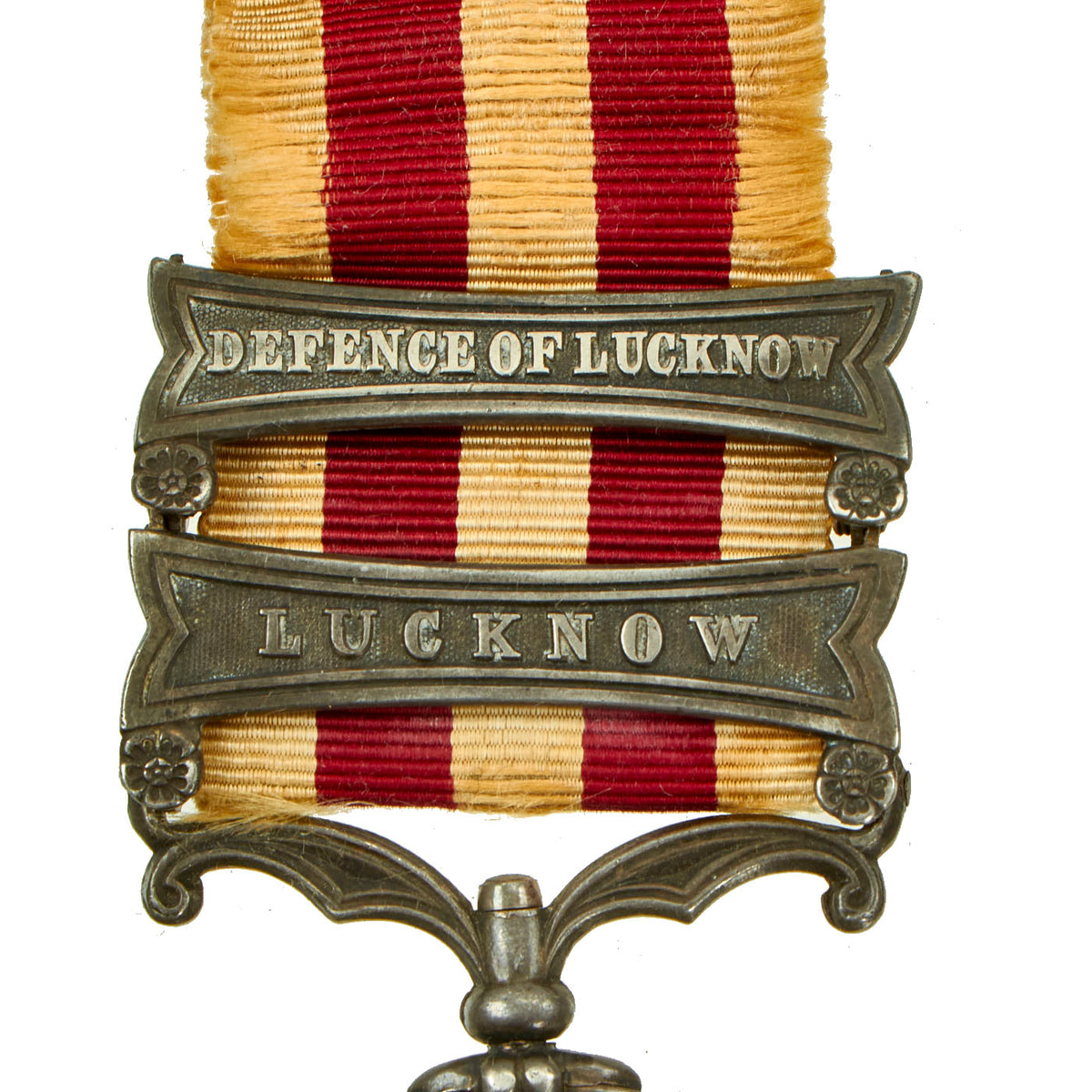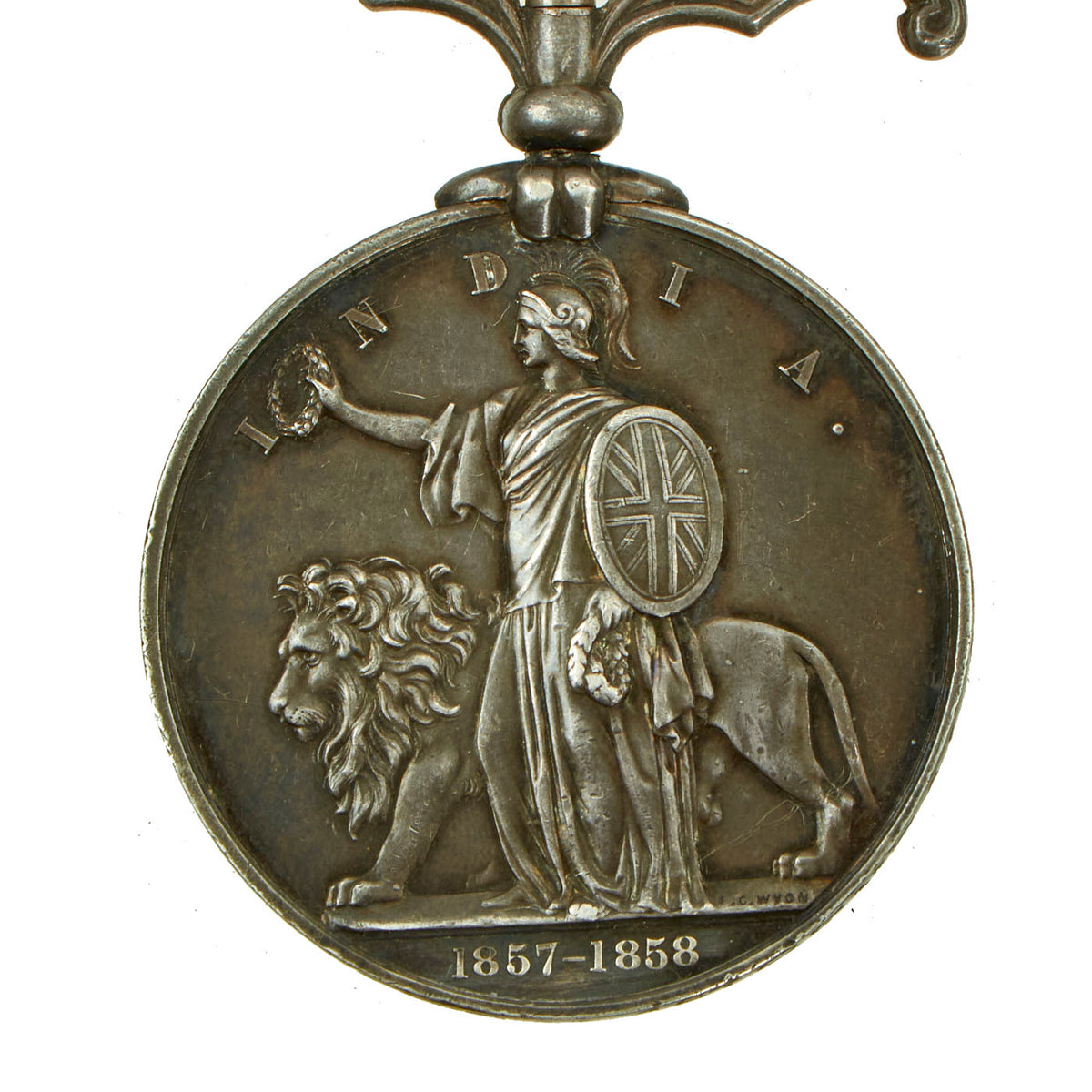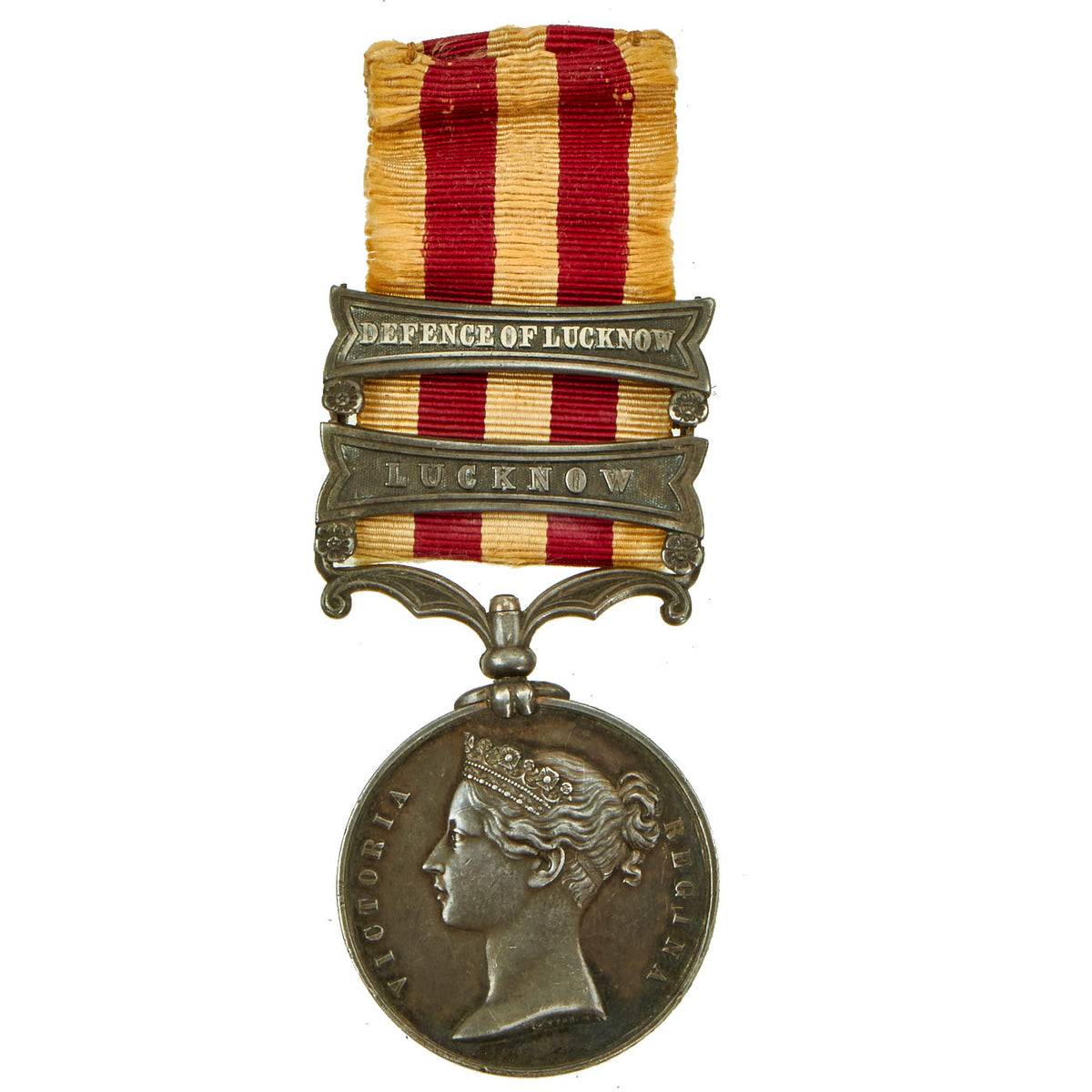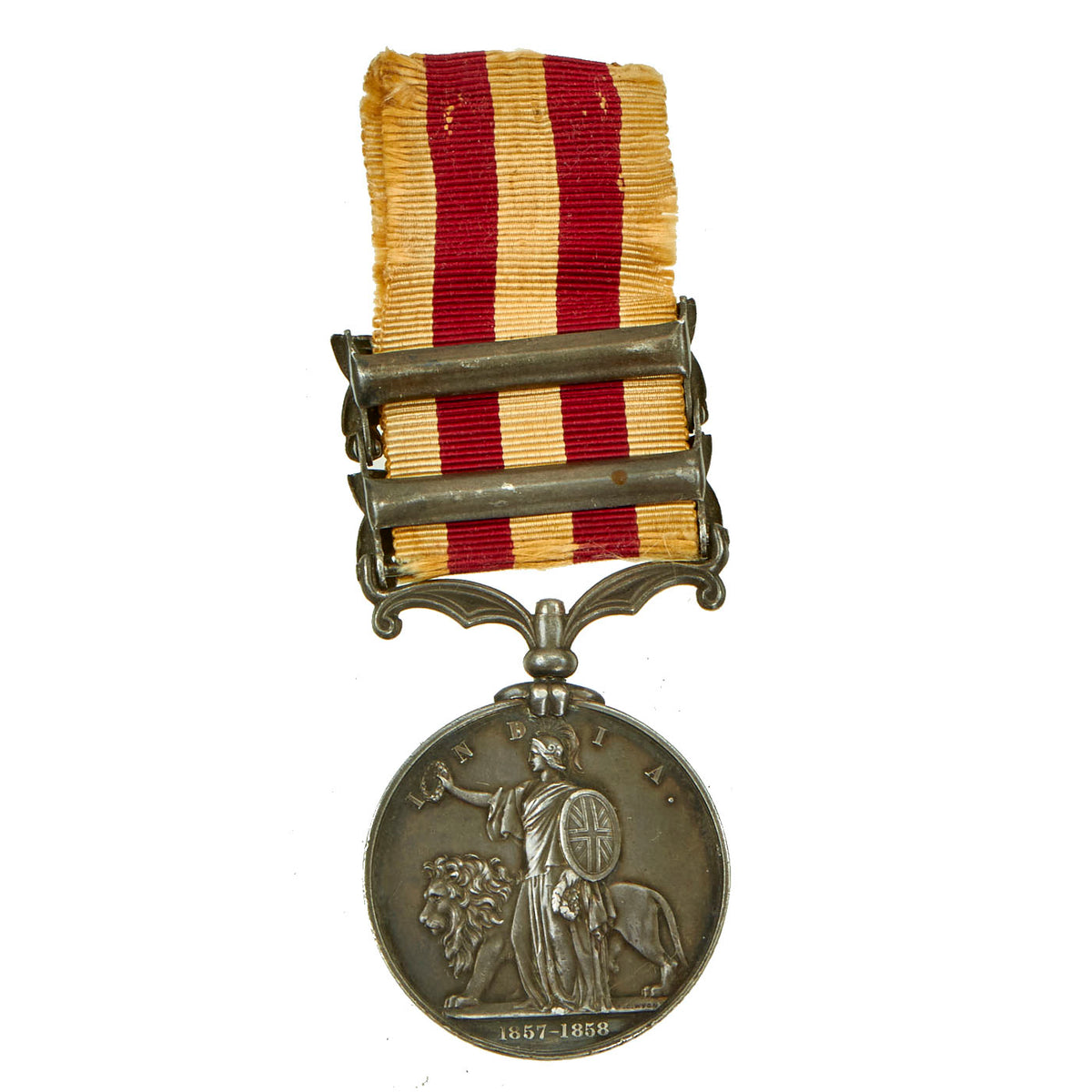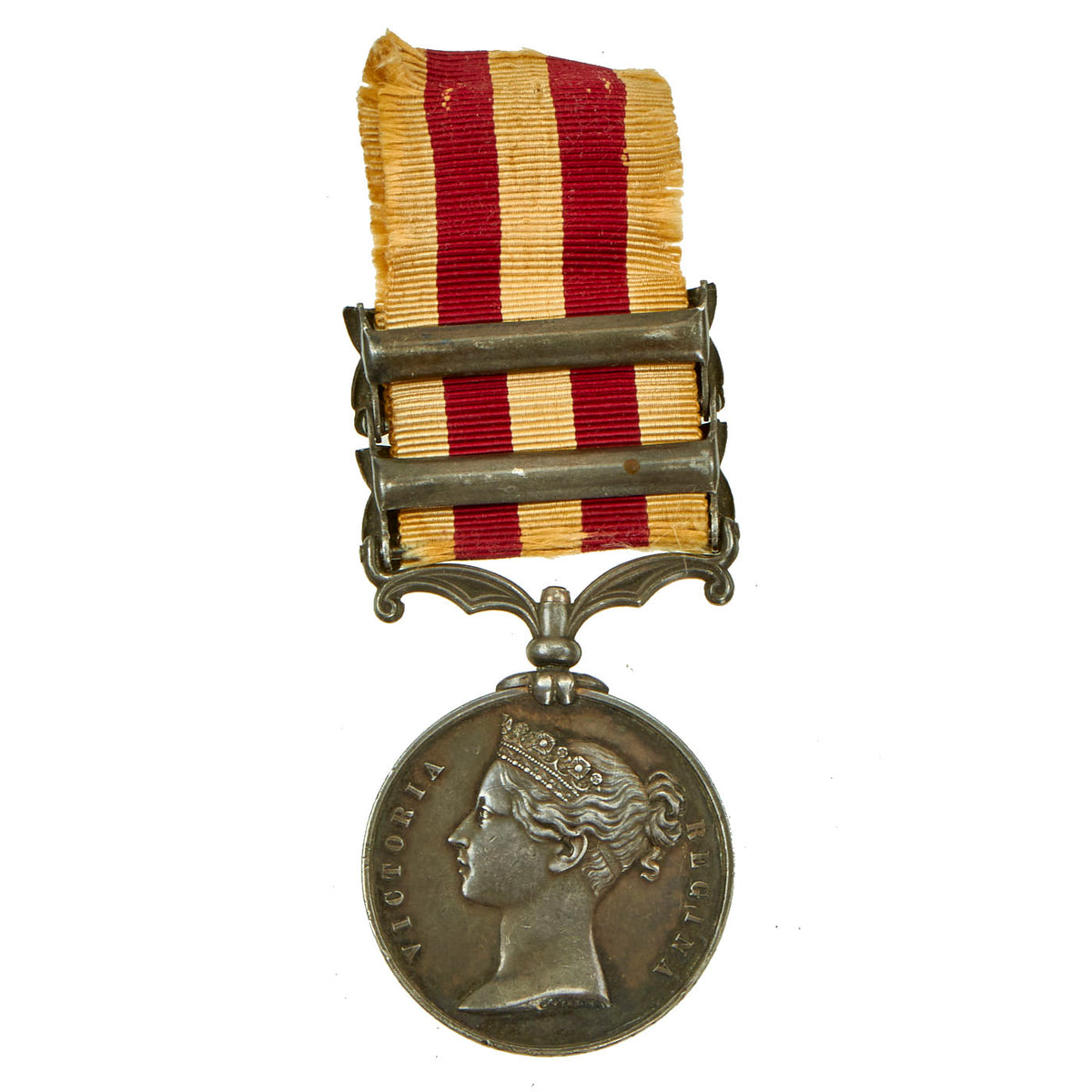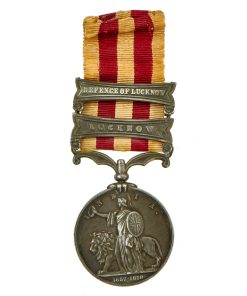Original British Indian Mutiny Named Campaign Medal To Defender of Lucknow – Gunner A. Watson 1st Bengal Artillery Original Items
$ 1.295,00 $ 323,75
Original Item: Only One Available. The Indian Rebellion of 1857 was a major uprising in India in 1857–58 against the rule of the British East India Company, which functioned as a sovereign power on behalf of the British Crown. The rebellion began on 10 May 1857 in the form of a mutiny of sepoys of the Company’s army in the garrison town of Meerut, 40 mi (64 km) northeast of Delhi. It then erupted into other mutinies and civilian rebellions chiefly in the upper Gangetic plain and central India, though incidents of revolt also occurred farther north and east. The rebellion posed a considerable threat to British power in that region, and was contained only with the rebels’ defeat in Gwalior on 20 June 1858. On 1 November 1858, the British granted amnesty to all rebels not involved in murder, though they did not declare the hostilities to have formally ended until 8 July 1859. Its name is contested, and it is variously described as the Sepoy Mutiny, the Indian Mutiny, the Great Rebellion, the Revolt of 1857, the Indian Insurrection, and the First War of Independence.
This medal is rim engraved to a member of the 1st Bengal Artillery in the Bengal Army. The Bengal Army was the army of the Bengal Presidency, one of the three presidencies of British India within the British Empire.
The Presidency armies, like the presidencies themselves, belonged to the East India Company (EIC) until the Government of India Act 1858 (passed in the aftermath of the Indian Rebellion of 1857) transferred all three presidencies to the direct authority of the British Crown. In 1895 all three presidency armies were merged into the British Indian Army.
The East India Company’s Bengal Army in 1857 (Bombay and Madras had their own armies) consisted of 151,361 men of all ranks, of whom the great majority – 128,663 – were Indians.
A total of 64 Bengal Army regular infantry and cavalry regiments rebelled during the Indian Rebellion of 1857, or were disbanded after their continued loyalty was considered doubtful. From 1858 onwards the actual high-caste Awadhi, Bengali and Bihari Hindu presence in the Bengal Army was reduced because of their perceived primary role as “mutineers” in the 1857 rebellion. The new and less homogeneous Bengal Army was essentially drawn from Punjabi Muslims, Sikhs, Gurkhas, Baluchis and Pathans, although twelve of the pre-mutiny Bengal line infantry regiments continued in service with the same basis of recruitment, traditions and uniform colors as before.
The Indian Mutiny Medal was a campaign medal approved in August 1858, for officers and men of British and Indian units who served in operations in suppression of the Indian Mutiny.
The medal was initially sanctioned for award to troops who had been engaged in action against the mutineers. However, in 1868 the award was extended to all those who had borne arms or who had been under fire, including such people as members of the Indian judiciary and the Indian civil service, who were caught up in the fighting. Some 290,000 medals were awarded.
The obverse depicts the diademed head of a young Queen Victoria with the legend VICTORIA REGINA, designed by William Wyon.
The reverse shows a helmeted Britannia holding a wreath in her right hand and a union shield on her left arm. She is standing in front of a lion. Above is the word INDIA, with the dates 1857–1858 below. The reverse was designed by Leonard Charles Wyon, who also engraved the die of the medal.
The 1.25 inches (32 mm) wide ribbon is white with two scarlet stripes, with each stripe of equal width.
The recipient’s name and unit is impressed on the rim of the medal in block Roman capitals:
GUNR A. WATSON 1ST BENGAL ARTY
The medal has two clasps present on the ribbon:
– LUCKNOW: November 1857 – March 1858. Awarded to troops under command of Sir Colin Campbell who were engaged in final operations leading to the surrender of Lucknow and the clearing of the surrounding areas.
– DEFENCE OF LUCKNOW: 29 June – 22 November 1857. Awarded to original defenders of Lucknow, including the masters and boys of La Martinière College in Lucknow who escaped to the Residency and assisted in its defense, and to the first relief force commanded by Sir Henry Havelock.
The medal was issued without a clasp to those who served, but were not present during these major operations. The majority of these awards were made as a result of the 1868 extension of eligibility.
The overall condition is excellent given the age of the award. There is minor age toning to the ribbon and tarnishing on the actual medal and clasps, but nothing too damaging nor anything to take away from the beauty of the medal.
We have not been able to locate the service record information for A. Watson making this a wonderful research opportunity.
Comes more than ready for further research and display!
The Indian rebellion was fed by resentments born of diverse perceptions, including invasive British-style social reforms, harsh land taxes, summary treatment of some rich landowners and princes, as well as skepticism about the improvements brought about by British rule. Many Indians rose against the British; however, many also fought for the British, and the majority remained seemingly compliant to British rule. Violence, which sometimes betrayed exceptional cruelty, was inflicted on both sides, on British officers, and civilians, including women and children, by the rebels, and on the rebels, and their supporters, including sometimes entire villages, by British reprisals; the cities of Delhi and Lucknow were laid waste in the fighting and the British retaliation.
After the outbreak of the mutiny in Meerut, the rebels quickly reached Delhi, whose 81-year-old Mughal ruler, Bahadur Shah Zafar, was declared the Emperor of Hindustan. Soon, the rebels had captured large tracts of the North-Western Provinces and Awadh (Oudh). The East India Company’s response came rapidly as well. With help from reinforcements, Kanpur was retaken by mid-July 1857, and Delhi by the end of September. However, it then took the remainder of 1857 and the better part of 1858 for the rebellion to be suppressed in Jhansi, Lucknow, and especially the Awadh countryside. Other regions of Company-controlled India—Bengal province, the Bombay Presidency, and the Madras Presidency—remained largely calm. In the Punjab, the Sikh princes crucially helped the British by providing both soldiers and support. The large princely states, Hyderabad, Mysore, Travancore, and Kashmir, as well as the smaller ones of Rajputana, did not join the rebellion, serving the British, in the Governor-General Lord Canning’s words, as “breakwaters in a storm.”
In some regions, most notably in Awadh, the rebellion took on the attributes of a patriotic revolt against British oppression. However, the rebel leaders proclaimed no articles of faith that presaged a new political system. Even so, the rebellion proved to be an important watershed in Indian and British Empire history. It led to the dissolution of the East India Company, and forced the British to reorganize the army, the financial system, and the administration in India, through passage of the Government of India Act 1858. India was thereafter administered directly by the British government in the new British Raj. On 1 November 1858, Queen Victoria issued a proclamation to Indians, which while lacking the authority of a constitutional provision, promised rights similar to those of other British subjects. In the following decades, when admission to these rights was not always forthcoming, Indians were to pointedly refer to the Queen’s proclamation in growing avowals of a new nationalism.
Fast Shipping with Professional Packaging
Thanks to our longstanding association with UPS FedEx DHL, and other major international carriers, we are able to provide a range of shipping options. Our warehouse staff is expertly trained and will wrap your products according to our exact and precise specifications. Prior to shipping, your goods will be thoroughly examined and securely secured. We ship to thousands clients each day across multiple countries. This shows how we're dedicated to be the largest retailer on the internet. Warehouses and distribution centres can be located throughout Europe as well as the USA.
Note: Orders with more than one item will be assigned a processing date depending on the item.
Before shipping before shipping, we'll conduct a thorough inspection of the items you have ordered. Today, the majority of orders will be delivered within 48 hours. The delivery time will be between 3-7 days.
Returns
The stock is dynamic and we cannot completely manage it because multiple stakeholders are involved, including our factory and warehouse. So the actual stock may alter at any time. It's possible that you may not receive your order once the order has been made.
Our policy is valid for a period of 30 days. If you don't receive the product within 30 days, we are not able to issue a refund or an exchange.
You can only return an item if it is unused and in the same state as the day you received it. You must have the item in its original packaging.
Related products
Uncategorized
Uncategorized
Uncategorized
Uncategorized
Uncategorized
Uncategorized
Uncategorized
Uncategorized
Uncategorized
Uncategorized
Armored Burgonet Helmet & Polearm from Scottish Castle Leith Hall Circa 1700 Original Items
Uncategorized
Angolan Rebel 1970s era 60mm Inert Display Mortar from Angolan Civil War Original Items
Uncategorized
Uncategorized
Uncategorized
Band of Brothers ORIGINAL GERMAN WWII Le. F.H. 18 10.5cm ARTILLERY PIECE Original Items
Uncategorized
Australian WWII Owen MK1 Machine Carbine SMG Custom Fabricated Replica with Sling Original Items
Uncategorized
Uncategorized
Uncategorized
Uncategorized
Uncategorized

